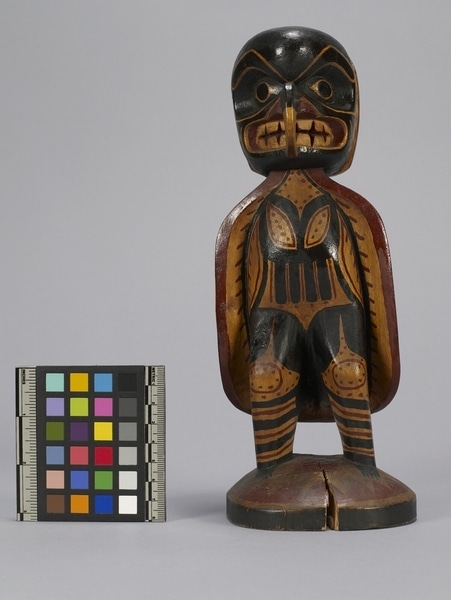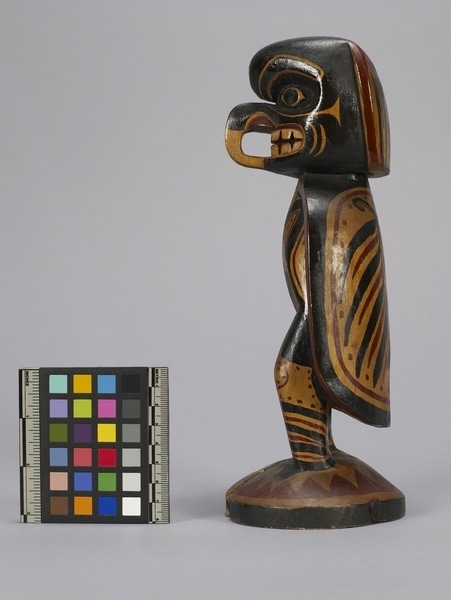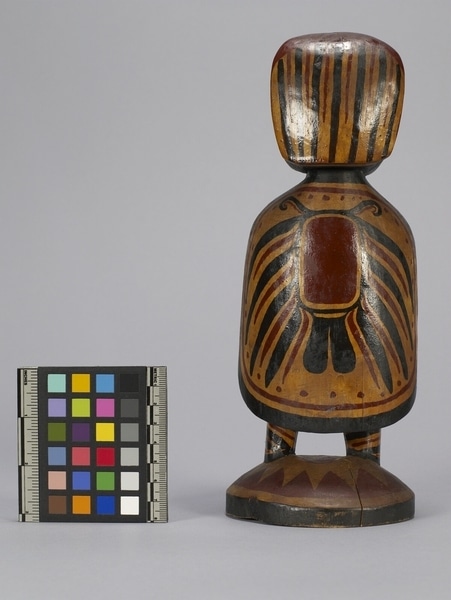Figure Item Number: A2212 from the MOA: University of British Columbia




Description
Miniaturized depiction of a Thunder dancer, standing upright on a rounded base. The dancer is wearing a mask, with a prominent forehead and beak-like nose, and a dance cape, which covers their back. Painted in black, red and yellow.
History Of Use
The Nuxalk "Thunder" being is not a bird, but rather a type of supernatural being. (Nuxalk people are adamant that Thunder beings are not the same as "Thunderbirds”, an important distinction in differentiating Nuxalk beliefs from their neighbours.) Painted scalloping and sawtooth designs are diagnostic of Dick Snow’s artwork, and the design on the back represents the wooden slats that would have attached to the Thunder regalia, for movement while dancing.
Specific Techniques
The black paint was made out of pulverized black stone mixed with salmon eggs, and the burgundy/red pigment was made with pulverized red rocks, salmon eggs, and sometimes mixed with red dye from alder that Snow's wife used to dye cedar bark.
Narrative
Dick Snow’s grandson, Chief Jeffrey Snow (7ANISPUXALS), remembers that his grandfather carved these miniatures for sale, rather than something like masks, to prevent non-Native people from disrespecting the Smayusta (family-owned origin stories) of the objects. Jeffrey Snow, along with Marshall Hans (Komokwa, also Dick Snow’s grandson), remember Dick Snow making his own pigment paints out of mineral rocks that he gathered himself from around the Bella Coola Valley. Dick Snow sold his carvings right from his house in Bella Coola, filling a curio cabinet in his living room with work and turning it to face out the window. Customers would come and buy the work directly from the artist.
Item History
- Made by Dick Snow ? (Maker) in British Columbia, Canada
- Collected in Port Simpson, British Columbia, Canada and Lax Kw'alaams, British Columbia, Canada
- Owned by F. G. Sherbourne
- Owned by Mrs. F. G. Sherbourne before 1948
- Received from Mrs. F. G. Sherbourne (Donor) during 1948
What
Who
- Culture
- Nuxalk
- Creator
- Dick Snow ? (Maker)
- Previous Owner
- F. G. Sherbourne and Mrs. F. G. Sherbourne
- Received from
- Mrs. F. G. Sherbourne (Donor)
Where
- Holding Institution
- MOA: University of British Columbia
- Made in
- British Columbia, Canada
- Collected in
- Port Simpson, British Columbia, Canada and Lax Kw'alaams, British Columbia, Canada
When
- Ownership Date
- before 1948
- Acquisition Date
- during 1948
Other
- Item Classes
- carvings & sculpture
- Condition
- good
- Accession Number
- 2157/0005